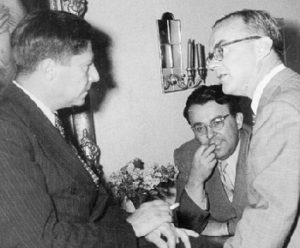Étiquette : CIA
ArtistCloseUp interviews Karel Vereycken on the creative method

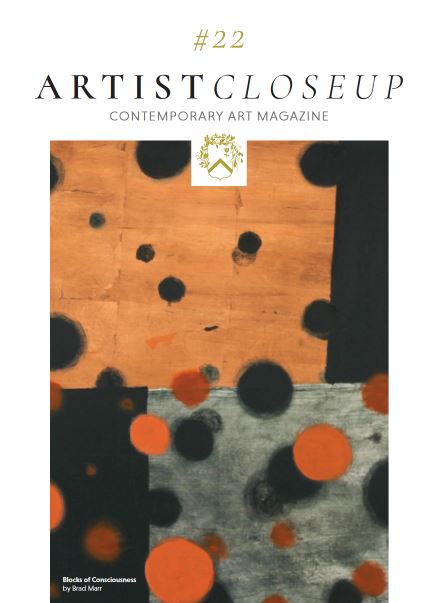
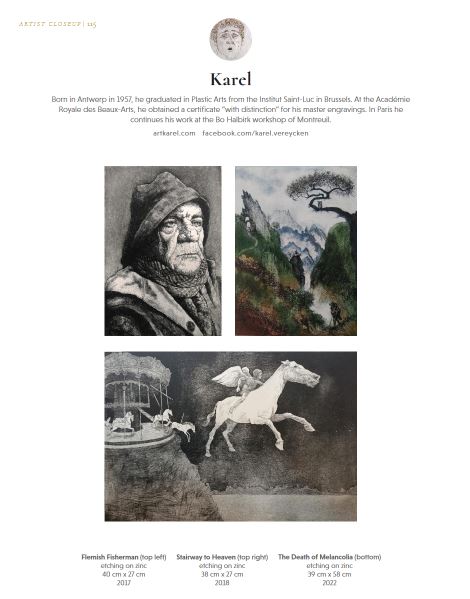
In its september 2024 issue #22, the Contemporary Art Magazine ArtistCloseUp, widely read among professionnals, presented some works of the French-Belgian Painter-engraver Karel Vereycken.
On July 23, the magazine published an online interview with Karel on what motivates him and his creative method.
Karel Vereycken
Born in 1957 in Antwerp, Karel graduated from the Institut Saint-Luc in Brussels and trained in engraving at the Académie Royale des Beaux-Arts, where he obtained a certificate of passage « with distinction. » In France, as a member of the Fédération nationale de l’estampe, he confirmed his technical mastery at Atelier63 and continued to perfect his skills in the Paris workshop of Danish engraver Bo Halbirk.
Complete biography
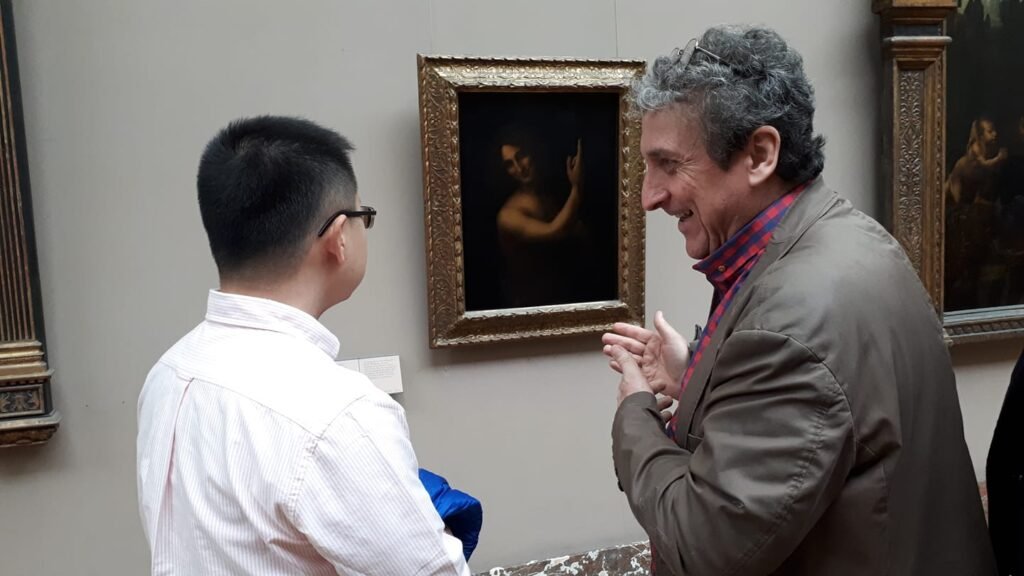

Written By Editorial Team
What is your background and how did you start your journey in the art world?
“I was born in 1957 in Antwerp. My parents worked in the port and the ship repair industry. Their adolescence, studies and careers were reduced to zero by the war period and the need to bring an income and feed their brothers, parents and family. So for their children, my parents thought we should have the occasion to fully enjoy and explore the cultural dimensions.
My mother, who was prevented by the war to become an opera singer, got me into a music school. But at that time, the teaching methods, basically learning to read scores for two years before ever being allowed to sing, were so repugnant that I ran away from that. As an alternative, my mother sent me to a communal drawing school directed by a talented sculptor named Herman Cornelis. The bearded cigar-smoking giant would rip pages out of old books and stick them in my hands saying “copy this!”
At the same time, my father would take me every weekend to visit the numerous museums of Antwerp where paintings of Bruegel, Rembrandt, Bosch, Rubens, Van Eyck and many other Flemish masters were on show. Father couldn’t really explain why but knew this was somehow very important.
Antwerp has also a well preserved XVIth century print shop of Christopher Plantin, a French humanist who worked in that city in the 16th century with many cartographers such as Mercator and Ortelius, whose engraved globes and printed maps impressed me deeply.
Then, at age 12, I won my first art prize and my teacher convinced my mother “there was precious talent” in me. With that advice, my mother sent me to Brussels to attend the Saint Luke Art School and study Plastic Arts. Some teachers were quite annoying but others got us into deep study of anatomy, examining Leonardo da Vinci and Albrecht Dürer’s groundbreaking studies. I continued another two years at the Ecole Royale des Beaux Arts of Brussels to study copper engraving and got graduated “with distinction.”
I then moved to Paris and worked as a journalist and editor of a non-commercial militant paper. But after some years, I found out art was really lacking in my life so I returned to it. First by producing copies of old masters painting on wooden oak panels with hand-made egg tempera, venitian turpentine and various other ancient oil techniques I rediscovered with a friend of mine.
Since the people that ordered these painting took them home, at the end, I had nothing to put on show. Therefore, I returned to watercolors and etching. I also gave a three year course of drawing for some of my friends, mainly amateurs and beginners.”
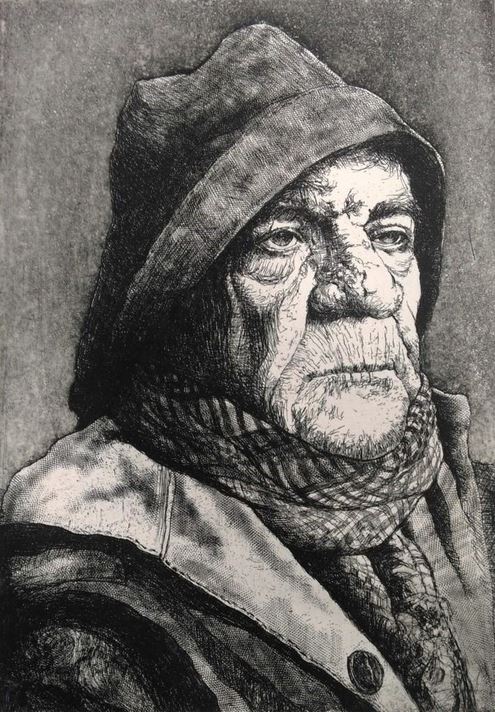
What inspires you?
“What always attracted me in painting and imagining is the way art “makes visible” things and ideas that are “not visible” as such in the simple visible world but which “appear” in the minds of the viewer.
It took me over twenty years to sort out the difference between “symbols” (a “convention” accepted among a group or a code system designed to communicate a secret meaning), and “metaphor” which by assembling things unusual, by irony and paradox, allows the individual mind to “discover” the meaning the painter intended to transmit.
Such an approach offers the joy of discovery and surprise, a deep human quality. Modern art started as a non-figurative form of symbolism till “contemporary” art brought many artists to put an axe into the very idea of poetical meaning.
In 1957, the CIA sponsored, under various covers and often without the artists even knowing about it, many “abstract” artists to promote a form of art that it considered coherent with its ideology of “free enterprise.”
So what inspires me is true human culture, be it Chinese painting of the Song dynasty, the Buddhist sculptures of Gandhara, the early Flemish masters or the magnificent bronze heads of Ifé in current Nigeria. Bridging the distances in space and time, religion and philosophy, stands the celebration of unique human capacities, that of compassion, empathy and love.”
What themes do you pursue? Is there an underlying message in your work?
“I don’t pursue themes, they pursue me! My aim is to shock people by showing them that nothing is more “modern” and “revolutionary” than “classical” art, not understood as annoying academic formalism, but as a science of composition based on non-cynical, liberating ironical poetical metaphors, who are the key to all forms of art be it in the domain of the visual arts or music. Art is always a “gift” from the artist to the viewers and the act of giving is an act of love. That is the message.”
How would you describe your work?
“I consider my work as part of a teaching activity, as a sort of humanistic intellectual guerrilla “warfare.” Even if I appreciate selling my works, and get more resources available for my art work, I’m definitely not out to please a given public or to market an aesthetic object. What counts for me is to get viewers to reflect on how “art” can be a “window” to a dimension people intuitively know as important but were never given access to.
I also took dozens and dozens of friends on guided tours at the Louvre in Paris, to the Frankfurt Museum or to the Metropolitan in New York. Some of these guided visits have been audio-taped and are available on my website. After these tours, most of those I guided thanked me warmly saying “I never even suspected to what degree ideas are transmittable through paintings.””
Which artists influence you most?
“I have studied in depth the European renaissance in the works of Ghiberti, Van Eyck, Leonardo, followed by Piero della Francesca and Dürer, arab optical science gave us the science of perspective representation. I wrote several book-length articles on Rembrandt whose tenderness and profoundness moved me to tears. But if one looks to his life, he’s main quality was not his natural talent alone but the fact that he was such a hard worker. For example, to have your portrait done by Rembrandt, you had to pause for some time every day in his studio during at least three months! Having natural talents makes artists lazy! But having good results after much hard work is the trait of genius.
Deciphering Hieronymus Bosch images in his paintings brought me to explore all the ironies of the 15th Century’s Dutch language brought up by Erasmus and his circles. Viewing all of Goya’s work on show in Madrid was another shock to the degree that his painting is so political while remaining beautiful visual poetry in its own right. Emotionally, I identify mostly with him who saw, just as me, both Rembrandt, Erasmus and Bosch as the sources of his elan. Today, Gandhara Buddhist art is adding new dimensions I ignored and helps me to add the required nuances to my views mostly centered on European art.”
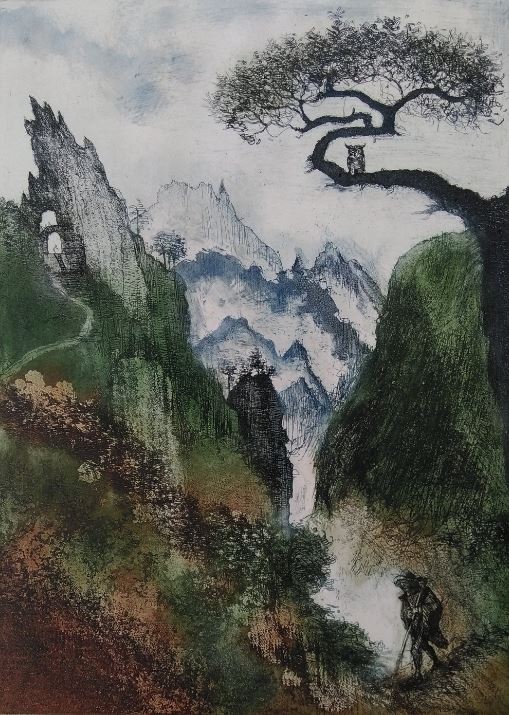
What is your creative process like?
“It takes a lot of courage to overcome the fear to be “completely alone” while you walk a road nobody ever walked on. Everything starts by having a “spark” of imagination and forge it into paradoxical metaphors. As an example, the way I created my work Stairway to Heaven (color etching on zinc, image 3). It started with my examination of the fantastic Chinese landscape paintings. Going through pictures of Chinese landscapes, I realized some of these paintings were not pure imagination but based on landscapes that really existed. The most fascinating of them are certainly those of an area called “Yellow mountains.”
Now at that time, I was also unraveling the way the Flemish painter Joachim Patinir painted his landscapes, as objects for religious contemplation. In the latter’s painting, man is seen, as in Augustinian philosophy, as a pilgrim, who has to learn how to detach himself from earthly possessions, that attachment considered a source of evil. The pilgrim is at the crossroads. By his free will he has to decide, either to take the easy road downhill or the difficult road uphill where he will reach out by going through a small gate.
So in my etching, I “married” a landscape from this Flemish school (on the left) with a view of China’s Yellow mountain. Initially, I had left out the pilgrim, but by working on the landscape, the idea came back to my mind. To accentuate that the road downhill was the road to evil, I added an owl, in Flemish folk art a symbol of evil since able to see in the dark and to grab you in your weakness. So, as one of my friends says, “behind Karel’s works, there’s always a story,” but it is up to you to discover it !”
What is an artist’s role in society and how do you see that evolving?
“I see on the internet dozens of very talented artists, the world is full of them! But what is required is a turn. What we need are political and financial elites willing to promote a culture that give these talents the chance and the means to shape the public and urban living space. We need a “culture of art” that makes people more and not less human.
As the German poet Friedrich Schiller said in his poem “The artists,” it is them that have the dignity of mankind in their hands, with them humanity rises or falls. Today, a much required turn is desirable. The despicable dictatorship of a handful of greedy gallerist sitting in London, Zurich, Venice and Geneva and deciding who is or is not a valuable artist should be brought to an end and I’m not even mentioning the laundering of criminal money it involves.”
Have you had any noteworthy exhibitions you’d like to share?
“With my colleagues from the workshop of Bo Halbirk in Montreuil, it was really nice in June 2024, to present my works at the 6th Exhibit of Contemporary Prints at the Paris Saint-Sulpice market. Going public, meeting art lovers and fellow artists is always a pleasure and a way to open new avenues. I need more of that!”
Website: artkarel.com
Instagram: @karelvereycken
Other links: www.facebook.com/karel.vereycken
The Congress for Cultural Freedom: How the CIA « weaponized » Modern Art
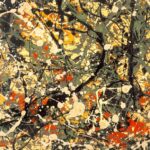

This article, first published in 2006, came as a book review of the book Who Paid the Piper of British researcher Frances Stonor Saunder, published in French Article under the title Qui mène la danse? La CIA et la guerre froide culturelle, 506 pages, Editions Denoël, Paris, 2003.
This book, which caused a stir in Germany, England and the Hispanic world, is literally appalling. Not only for what it reveals, but above all for what it leaves unsaid.
After years of meticulous research, interviews and archival work, the young writer Frances Stonor Saunders, producer of historical documentaries for the BBC, delivers an uncompromising account of the Anglo-American cultural Cold War against the Soviet Union from 1947 onwards.
Congress for Cultural Freedom
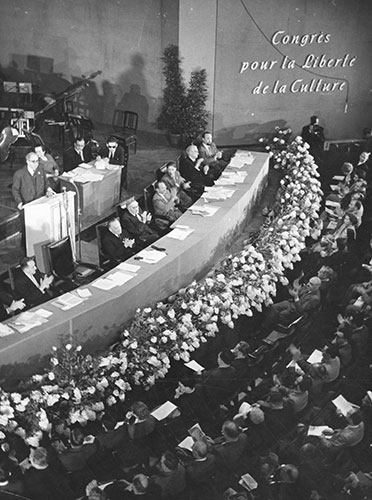
At the heart of this secret « Kulturkampf », a veritable cultural Cold War, was the Paris-based Congress for Cultural Freedom (CCF), headed from 1950 to 1967 by CIA agent Michael Josselson.
Josselson, who spoke four languages, along with music composer Nicholas Nabokov, was a former member of the psychological warfare division of the Office for Strategic Services (OSS), which US President Harry Truman replaced with the CIA in 1945.
The first thing that strikes the reader is the analogy between the language of the Cold War and the narrative of today’s war hawks to justify a new crusade « against terrorism. »
Back then, under the guise of a merciless struggle against the horrors of Stalinism, the Anglo-American imperial faction deployed whole swathes of the CIA in an attempt to impose Bertrand Russell‘s utopian vision of « world government. »
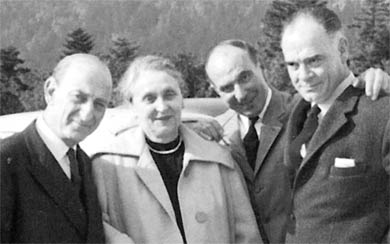
The CIA described itself as an « Order of Knights Templar » charged with « saving Western freedom from Communist darkness ». Its principal theoretician was George Kennan, Director of the Policy Planning Staff at the State Department.
Like the « Noble Lies » employed today by the neo-conservatives, followers of Leo Strauss, Kennan asserted in 1947 that the Communists had gained a position of prominence in Europe,
« through the shameless and skillful use of lies. They fought us with the weapon of unreality and irrationalism. Can we triumph over this unreality with rationalism, truth, honest and well-intentioned economic assistance? »
Obviously not! And the most formidable weapon for world domination will be, as always: the soft power of « culture ».
Indeed, « you can’t be a great power if you don’t have the art to go with it, it’s like Venice without Tintoretto or Florence without Giotto ».
So, ironically, while American public opinion was held hostage by the McCarthyite psychosis for whom « all modern art is communist », to the point of suspecting certain abstract paintings of indicating the exact location of American military bases (sic), the oligarchs saw in « lyrical abstract » expressionism the virtues of a specifically anti-communist ideology.
By a simple logic of inversion, everything that Nazis and Stalinists considered « degenerate art » automatically became emblematic of the values of freedom and free enterprise, and therefore got massively financed… in the greatest secrecy.
With a wealth of detail, the author documents the mesh of this operation over some five hundred pages. It is, of course, impossible to summarize here the descriptions of the lives of dozens of men, women, musicians, authors, magazines, networks and foundations, each page of which delivers a few pearls.
Some of the details shed a special light on contemporary French history.
The CIA in Paris
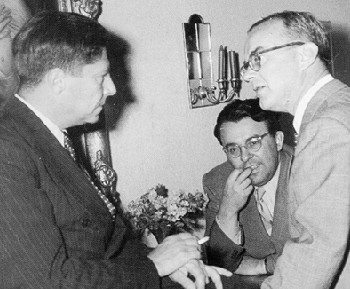
In Paris, it was Irving Brown (1911-1989), a representative of the powerful AFL-CIO union (with free access to secret Marshall Plan funds), who offered the CCF in Paris a suite in the Hôtel Baltimore on Avenue Kléber to set up its temporary headquarters, before paying the rent for a permanent office on Boulevard Haussmann.
On behalf of his boss Jay Lovestone (1897-1990), himself a helper of the CIA’s James Jesus Angleton, Irving Brown financed anything that might weaken France’s resistance to the utopia of world government, i.e. anything that might harm Gaullism and, to a certain extent, Communism.
Josselson and his wife met him quite often in a gay bar, « L’Indifférent ». One evening, they find him handing over a large sum of money to a Marseille mobster. A fan of the big boys, Brown was heavily involved in anything that could reduce the influence of the Communists.
It was from that perspective that he helped former members of the Vichy government, as well as Trotskyites. He controlled French ports, broke strikes and financed the new Force Ouvrière union to split the CGT communist union, all the while promoting modern art!*
Alongside Irving Brown, the CCF board included Michael Josselson, Lawrence de Neufville (his CIA recruiter, later appointed to Radio Free Europe), Arthur Koestler, Melvin Lasky, former Trotskyist James Burnham, as well as Carlo Schmid of the German SPD, Haakon Lie, leader of the Norwegian Labour Party, and David Rousset of the French Parti Socialiste.
In his book The Machiavellians, Burnham used Machiavelli to « challenge egalitarian political theory and show the persistence and inescapability of the elite, even in an age of equality ».
In 1953, Burnham played a crucial role in the CIA’s Operation AJAX, which overthrew Dr. Mossadegh in Teheran and replaced him with the Shah.
Later, « more presentable » funding sources than Irving Brown came into play: CIA front organizations such as the Farfield Foundation, headed by Julius Fleischman, or the Hoblitzelle Foundation, but also classics like the Ford, Carnegie or Rockefeller brothers’ foundations.
Thanks to these generous donors, the CCF made millions of dollars available to literary magazines such as
- Encounter, edited by former Trotskyite Irving Kristol (father of current neo-conservative William Kristol) in London;
- Preuves, edited in Paris by François Bondy of the European Union of Federalists;
- Der Monat, edited by Melvin Lasky in Berlin;
- Tempo Presente, edited by Ignazio Silone in Rome;
- Soviet Survey, edited in Israel by historian Walter Laqueur.
After the OSS’s (reciprocal) expressions of sympathy for Hemingway or Antoine de Saint-Exupéry, these magazines opened their columns to authors such as Jorge-Louis Borges, Raymond Aron, Arnold Toynbee, Bertrand Russell, Arthur Schlesinger Jr., Herbert Read or Hugh Trevor-Roper, or contributed to the publication of their writings.
In 1950, the CIA commissioned the production of a cartoon based on George Orwell’s Animal Farm (real name Eric Blair).
Also in Paris, CIA man Peter Matthiessen helped found the Paris Review run by John Train, a far-right liberal New York billionaire.
CIA Culture

Destruction of the well tempered music
The CCF also financed major musical events to promote « modern » twelve-tone serialism (dodecaphony), such as the April 1952 festival organized by Nicolas Nabokov in Paris.
Nabokov believed that « dodecaphony abolishes natural hierarchies » and allows us to free ourselves from the internal logic of music.
Anne C. Shreffler argues that the « compositional avant-garde » was politicized more by its advocacy of personal freedom than by political influence. Shreffler goes on to argue that both the Soviet Union and the United States sent out messages that dealt with « freedom. » However, Western Europe and the United States claimed a « moral high ground » in the struggle for individual freedom, a high ground that made certain artistic aesthetics (e.g., cubism, surrealism, dodecaphony, and existentialism) almost « obligatory » for artists.
The promotion of « liberated » music as a counterpoint to « Social Realism« , which essentially « marginalized » the populist Soviet musical aesthetic, was explicitly a politically calculated move by the Congress for Cultural Freedom.
The festival opened with « The Rite of Spring » of Igor Stravinsky, new convert to twelve-tone dodecaphonic system.
Among the participants from the USA: Leontyne Price, Aaron Copland, Samuel Barber, the New York City Ballet (Balanchine‘s troupe), the Boston Symphony Orchestra, the New York Museum of Modern Art (MoMA), James T. Farrell, W.H. Auden and Gertrude Stein.
European participants included Jean Cocteau, William Walton, Laurence Olivier, Benjamin Britten, the Vienna Opera, Covent Garden Opera, Czeslaw Milosz, Denis de Rougemont and Guido Piovene, to name but a few.
Appointed Eisenhower’s special advisor on Cold War strategy, American Vice-President Nelson Rockefeller played a fundamental role in promoting the CIA’s modernist painting. Supporting left-wing artists practicing abstract expressionism was commonplace for the Rockefellers.
Nelson’s mother, Abby Aldrich Rockefeller, had founded the Museum of Modern Art in New York – the Modern Art Museum (MoMA) – asserting that reds would stop being reds « if we gave them artistic recognition ». Several MoMA trustees were also trustees of the Farfield Foundation, as indicated, a CIA front.
As Donald Jameson of the CIA put it:
« We understood that this was the kind of art that has nothing to do with social realism and makes it even more stylized, rigid and confined than it was. »
MoMA bought works by Diego Riviera, Jackson Pollock, Arshile Gorky, Alexander Calder, Robert Motherwell, Stuart Davis, Edward Hopper and others.
By attributing the « success » of an impressive number of contemporary cultural actors to the will of an imperial elite, motivated by a more than suspect ideological blindness and endowed, what’s more, with unparalleled financial resources and communication strategies, Stonor Saunders’ book immediately casts deep discredit on all post-war artistic creation.
Most of these « artists » were chosen because they conveyed an ideology deemed compatible with the totalitarian designs of the high priests of world order.
Only the reactionary Peregrine Worsthorne titles his book review of Saunders’ Who Paid the Piper, « How Western Culture was saved by the CIA », nostalgically lamenting the Machiavellian genius of the Anglo-American elite in its heyday.
Of course, some artists weren’t necessarily aware of the source of the funds, but they all expected them to fill their pockets… And perhaps most shockingly of all, the CIA took art more seriously than many citizens or critics of the time.
So, perhaps this survey does posthumous justice to all those talents sacrificed on the altar of illusory power. Think of all those crushed hopes, sabotaged careers and stifled seeds of genius. For in this delirious tournament of the Cold War, the great priesthood ruling over the art world would only saddle those willing to bend the knee, while with a wave of the hand, send others to the deadly silence of oblivion.
NOTE:
*In his book Les Trotskistes (Fayard, 2002), Christophe Nick states, with regard to the non-communist student union UNEF, that at one time, « thanks to Irwing Brown‘s good offices, the U.S. Embassy was able to cover the student union’s end-of-month budgets ».
In Secrets de famille (Fayard, Paris 2001), Serge Raffy reveals that « Lionel Jospin, then First Secretary of the Socialist Party, met in Washington on April 14, 1982 with leaders of the American AFL-CIO union to reassure them that the Mauroy government would include Communist ministers. The man who organized the meeting was a CIA agent, Irving Brown, the same man who founded and financed the French trade union Force Ouvrière to combat the Communist CGT financed by Soviet Russia. Irving Brown is also said to have constantly maintained links between the Trotskyites, and in particular the OCI, and FO. »
On the right, the student union, Union Inter-Universitaire (UNI), which made the career of so many politicians on the right, was also backed by CIA agent of influence Irving Brown and received $575,000 between April 1984 and April 1985 from the government of the United States through the National Endowment for Democracy.
Index, Études Renaissance

INDEX, Etudes Renaissance
- Mohenjo-Daro, Harappa: Le défi que nous lance la modernité de la Civilisation de l’Indus (FR en ligne);
- Mohenjo-Daro, Harappa : The challenging modernity of the Indus Valley Civilization (EN online);
- La Route de la soie maritime, une histoire de 1001 coopérations (FR en ligne)
- The Maritime Silk Road, a History of 1001 cooperations (EN online);
- Afghanistan, le pays des 1000 cités d’or et l’histoire d’Aï Khanoum (FR en ligne);
- Afghanistan: the Land of a 1000 Golden Cities and Aï-Khanoun (EN online);
- Le miracle du Gandhara, quand Bouddha s’est fait homme (FR en ligne);
- The miracle of Gandhara: when Buddha turned himself into man (EN online);
- Derrière les chevaux célestes chinois, la science terrestre (FR en ligne);
- The Earthly Science behind China’s Heavenly Horses (EN online);
- Et l’Homme créa l’acier… (FR en ligne);
- Portraits du Fayoum: un regard de l’au-delà (FR en ligne) + EN pdf (Fidelio);
- ARTKAREL LOUVRE AUDIO GUIDE: The Greek tradition behind the Fayum Mummy Portraits (EN audio);
- La pratique ancestrale d’annulation des dettes (FR en ligne);
- The Ancient Practice of Debt Cancelation (EN online);
- Bagdad, Damas, Cordoue, creuset d’une civilisation universelle (FR online);
- Mutazilisme et astronomie arabe, deux étoiles brillantes au firmament de la civilisation (FR en ligne). (EN online version);
- Qanâts perses et Civilisation des eaux cachées (FR en ligne). (EN online version).
- Renaissance africaine: la splendeurs des royaumes d’Ifè et du Bénin (FR en ligne) + (EN online);
- Sur la peinture chinoise et son influence en Occident (FR en ligne) + EN pdf (Fidelio).
- L’invention de la perspective FR pdf (Fusion) + EN pdf (Fidelio);
- La révolution du grec ancien, Platon et la Renaissance (FR en ligne)
- The Greek language project, Plato and the Renaissance (EN online).
- Les Frères de la vie commune et la Renaissance du nord (FR en ligne)
- Moderne Devotie en Broeders van het Gemene Leven, bakermat van het humanisme (NL online)
- Devotio Moderna, Brothers of the Common Life, the cradle of humanism in the North (EN online)
- 1405: l’amiral Zheng et les expéditions maritimes chinoises (FR en ligne)
- Jan van Eyck, la beauté comme prégustation de la sagesse divine (FR en ligne) + EN on line.
- Jan Van Eyck, un peintre flamand dans l’optique arabe (FR en ligne)
- Jan Van Eyck, a Flemish Painter using Arab Optics (EN online)
- Rogier Van der Weyden, maître de la compassion (FR pdf)
- ARTKAREL LOUVRE AUDIO GUIDE: Van der Weyden and Cusanus (EN online audio);
- Comment Jacques Cœur a mis fin à la Guerre de Cent Ans (FR en ligne);
- ARTKAREL LOUVRE AUDIO GUIDE: Who whispered in the Ear of Joan of Arc? (EN online audio);
- Hugo van der Goes et la Dévotion moderne (FR en ligne)
- A la découverte d’un tableau (FR en ligne)
- ARTKAREL LOUVRE AUDIO GUIDE: Ghirlandaio’s immortality (EN online audio);
- Avicenne, Ghiberti, leur rôle dans l’invention de la perspective à la Renaissance (FR en ligne) et EN online.
- ENTRETIEN Omar Merzoug: Avicenne ou l’islam des lumières (FR en ligne). + EN pdf.
- Les secrets du dôme de Florence (FR en ligne) + EN pdf (Schiller Institute archive website) + DE pdf (Neue Solidarität).
- ARTKAREL LOUVRE AUDIO GUIDE: Cimabue, Giotto, Fra Angelico; Wonders of the Italian Trecento (EN online audio);
- L’œuf sans ombre de Piero della Francesca (FR en ligne) + EN pdf (Fidelio).
- ARTKAREL LOUVRE AUDIO GUIDE: Antonello de Messina in the Image of Christ (EN audio online)
- Uccello, Donatello, Verrocchio et l’art du commandement militaire (FR en ligne) et EN online.
- ARTKAREL LOUVRE AUDIO GUIDE: Leonardo and Verrochio’s workshop (EN audio online)
- La Cène de Léonard, une leçon de métaphysique (FR en ligne) + EN pdf (Fidelio).
- Léonard de Vinci : peintre de mouvement (FR en ligne) + EN pdf (Fidelio).
- ARTKAREL LOUVRE AUDIO GUIDE: Mona Lisa made in China? (EN online audio);
- La Vierge aux rochers, l’erreur fantastique de Léonard (FR en ligne).
- Romorantin et Léonard ou l’invention de la ville moderne (FR en ligne) + EN pdf (Executive Intelligence Review) + DE pdf (Neue Solidarität) + IT pdf (Movisol website).
- L’Homme de Vitruve de Léonard de Vinci (FR en ligne) + EN online.
- Léonard en résonance avec la peinture traditionnelle chinoise — entretien avec Le Quotidien du Peuple. (en ligne: texte chinois suivi des traductions FR + EN).
- ARTKAREL LOUVRE AUDIO GUIDE: Why Leonardo didn’t like painting (EN online audio)
- Raphaël, entre mythe et réalité (FR pdf + EN pdf)
- Raphaël 1520-2020 : ce que nous apprend « L’Ecole d’Athènes » (FR en ligne).
- Raphael 1520-2020: What Humanity can learn from the « School of Athens » (EN online);
- Jacob Fugger « The Rich », father of financial fascism (EN online);
- Jacob Fugger « Le Riche », père du fascisme financier (FR en ligne);
- Comment la folie d’Erasme sauva notre civilisation (FR en ligne) + NL pdf (Agora Erasmus) + EN pdf (Schiller Institute Archive Website) + DE pdf (Neue Solidarität).
- Le rêve d’Erasme: le Collège des Trois Langues de Louvain (FR en ligne)
- Erasmus‘ dream: the Leuven Three Language College (EN online);
- ARTKAREL LOUVRE AUDIO GUIDE: Why Erasmus had no time to pause for portraits (EN online audio);
- ENTRETIEN: Jan Papy: Erasme, le grec et la Renaissance des sciences (FR en ligne)
- Dirk Martens, l’imprimeur d’Erasme qui diffusa le livre de poche (FR en ligne).
- 1512-2012 : Mercator et Frisius, des cosmographes aux cosmonautes + NL pdf (Agora Erasmus) + EN pdf (Schiller Institute Archive Website).
- La nef des fous de Sébastian Brant (FR en ligne), un livre d’une grande actualité !
- Avec Jérôme Bosch sur la trace du Sublime (FR en ligne) + EN pdf.
- ARTKAREL LOUVRE AUDIO GUIDE: How Bosch’s Ship of Fools drove the Jester out of business (EN online audio);
- Quinten Matsys and Leonardo — The Dawn of the Age of Laugher and Creativity, (EN online);
- Joachim Patinir et l’invention du paysage en peinture (FR en ligne).
- Joachim Patinir and the invention of landscape painting (EN online)
- Exposition de Lille : ce que nous apprennent les fabuleux paysages flamands (FR en ligne).
- Portement de croix: redécouvrir Bruegel grâce au livre de Michael Gibson (FR en ligne) + EN pdf (Fidelio).
- ENTRETIEN Michael Gibson: Pour Bruegel, le monde est vaste (FR en ligne) + EN pdf (Fidelio)
- Pierre Bruegel l’ancien, Pétrarque et le Triomphe de la Mort (FR en ligne) + EN online.
- A propos du film « Bruegel, le moulin et la croix » (FR en ligne).
- L’ange Bruegel et la chute du cardinal Granvelle (FR en ligne).
- Albrecht Dürer contre la mélancolie néo-platonicienne + EN pdf.
- How neo-Platonism gave Plato a bad name (EN pdf).
- Le combat inspirant d’Henri IV et de Sully + EN pdf (Schiller Institute Archives Website).
- La paix de Westphalie, une réorganisation financière mondiale (FR en ligne + EN online)
- Rembrandt, un bâtisseur de nations FR pdf (Nouvelle Solidarité).
- Rembrandt et la lumière d’Agapè (FR en ligne)
- Rembrandt and the Light of Agapè (EN online)
- Rembrandt : 400 ans et toujours jeune ! (FR en ligne).
- Rembrandt: 400 years old and still young ! (EN online).
- Rembrandt et la figure du Christ (FR en ligne) + EN pdf + DE pdf.
- Metsu, Ter Borch, Hals, l’éloge du quotidien. FR pdf (Nouvelle Solidarité);
- ARTKAREL LOUVRE AUDIO GUIDE: Why Vermeer was hiding his convictions (EN online audio);
- Entre l’Europe et la Chine: le rôle du jésuite flamand Ferdinand Verbiest. (FR en ligne).
- Francisco Goya et la révolution américaine (FR en ligne) + EN pdf (Fidelio) + ES pdf.
- BOOK: Karel Vereycken et Karl Lestar : El Degüello de Goya (livre ES)
- Beethoven et le Meeresstille: initiation à une culture de la découverte (FR en ligne) + EN pdf (Schiller Institute Archive Website) + DE pdf (Neue Solidarität).
- Mutual Tuition: historical curiosity or promise for a better future? (EN online)
- Enseignement mutuel: curiosité historique ou piste d’avenir? (FR en ligne)
- Le combat républicain de David d’Angers, la statue de Gutenberg à Strasbourg (FR en ligne)
- The republican struggle of David d’Angers and the Gutenberg statue in Strasbourg (EN online)
- Hippolyte Carnot, père de l’éducation républicaine moderne (FR en ligne)
- Hippolyte Carnot, father of modern republican education (EN online)
- Victor Hugo et le colosse (FR en ligne);
- Victor Hugo and the awakening of the colossus (EN online);
- Enquête sur les origines de l’art contemporain (FR en ligne) + EN pdf.
- On the Origins of Modern Art, the Question of Symbolism (EN online)
- Les racines symbolistes des killer games (FR en ligne).
- Neo-Platonism and Huxley’s Doors of Perception (EN online)
- L’art moderne de la CIA pour combattre le communisme (FR en ligne).
- The Congress for Cultural Freedom (CCF) – How the CIA « weaponized » Moder Art (EN online).
- M. Hockney, le génie artistique n’est pas une illusion optique ! FR pdf (Fusion) + DE pdf + EN pdf (21st Science & Technology).
- Gérard Garouste et La Source (FR en ligne).
- Rembrandt’s oil painting is back… in China ! (EN online)
- Ce que nous apprend l’expérience Trou-dans-le-Mur de Sugata Mitra (FR en ligne)
- The hidden lesson behing Sugata Mitra‘s Hole-in-the-Wall experience (EN online)
L’Art moderne de la CIA pour combattre le communisme
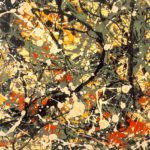
Article initialement publié le 8 août 2003 lors de la parution du livre Qui mène la danse ? La CIA et la guerre froide culturelle (Titre original : Who Paid the Piper, Frances Stonor Saunders), 506 pages, Editions Denoël, Paris, 2003, 24,50 euros.
Ce livre, qui fait grand bruit en Allemagne, en Angleterre et dans le monde hispanique, est littéralement effroyable. Par ce qu’il révèle, d’une part, mais surtout par les non-dits qu’il laisse transparaître. Après des années de recherche minutieuse, d’interviews et de travail d’archive, la jeune écrivain Frances Stonor Saunders, productrice de documentaires historiques pour la BBC, nous livre sans concession sa vaste enquête sur le bras de fer culturel auquel se livrèrent dès 1947 les Etats-Unis et l’Union soviétique.
Au coeur de ce « Kulturkampf » secret, véritable guerre froide culturelle, se trouve le « Congress of Cultural Freedom » (CCF, Congrès pour la liberté de la culture), basé à Paris et dirigé de 1950 à 1967 par l’agent de la CIA Michael Josselson.
Ce dernier, qui parlait quatre langues, avait appartenu, avec le compositeur de musique Nicholas Nabokov, à la division de guerre psychologique de l’Office for Strategic Services (OSS), que Truman remplaça par la CIA en 1945.
- La première chose qui frappe le lecteur, ce sont les analogies entre le langage de la guerre froide et les diatribes des faucons actuels, servant à justifier une nouvelle croisade contre le terrorisme. A l’époque, sous couvert d’une lutte sans merci contre les horreurs du stalinisme, la faction impériale anglo-américaine déploya des pans entiers de la CIA pour tenter d’imposer l’utopie d’un gouvernement mondial, prôné par Bertrand Russell.
La CIA se décrivait elle-même comme un « ordre de Templiers » chargé de « sauver la liberté occidentale des ténèbres communistes ». Son principal théoricien était George Kennan, directeur du Policy Planning Staff au Département d’Etat.
- A l’instar des « nobles mensonges » employés aujourd’hui par les faucons, adeptes de Léo Strauss, Kennan affirmait en 1947 que les communistes avaient acquis une position d’envergure en Europe « grâce à l’utilisation habile et sans vergogne de mensonges. Ils nous ont combattus avec l’arme de l’irréalité et de l’irrationalisme. Pouvons-nous triompher de cette irréalité par le rationalisme, la vérité, une assistance économique honnête et bien intentionnée ? »
- Évidemment non ! Et l’arme la plus redoutable pour dominer le monde sera, comme toujours, la culture.
En effet « on ne peut pas être une grande puissance si l’on n’a pas l’art qui va avec, c’est comme Venise sans le Tintoret ou Florence sans Giotto ».
Alors, ironiquement, tandis que l’opinion publique américaine est prise en otage par la psychose maccarthyste, pour qui « tout art moderne est communisant », au point de soupçonner certains tableaux abstraits d’indiquer l’emplacement exact des bases militaires américaines (sic), les oligarques voient dans l’expressionnisme abstrait les vertus d’une idéologie spécifiquement anticommuniste. Par une simple logique d’inversion, tout ce que nazis et staliniens considèrent comme un « art dégénéré » devient automatiquement emblématique des valeurs de liberté et de libre entreprise, et donc massivement financé… dans le plus grand secret.
Avec une foultitude de détails, l’auteur documente sur quelque cinq cents pages le maillage de cette opération. Il est bien sûr impossible de résumer ici les descriptions de la vie de dizaines d’hommes, femmes, musiciens, auteurs, magazines, réseaux et fondations, dont chaque page nous livre quelques perles. Certains détails croustillants jettent un éclairage particulier nous permettant de mieux comprendre l’histoire française contemporaine.
La CIA à Paris
A Paris, c’est Irving Brown (1911-1989), représentant du puissant syndicat AFL-CIO (bénéficiant d’un libre accès aux fonds secrets du plan Marshall), qui offre au CCF une suite à l’hôtel Baltimore, avenue Kléber, pour y établir son QG provisoire, avant de lui payer le loyer d’un local permanent boulevard Haussmann.
Pour le compte de son patron à la CIA, Jay Lovestone (1897-1990), ennemi juré de Lyndon LaRouche, Irving Brown finance tout ce qui peut affaiblir la résistance de la France à l’utopie d’un gouvernement mondial, c’est-à-dire tout ce qui peut nuire au gaullisme et, dans une certaine mesure, au communisme.
Josselson et sa femme le rencontrent assez souvent dans un bar homosexuel, « l’Indifférent ». Un soir, ils le trouvent en train de remettre une forte somme d’argent à un « gangster de Marseille ». Amateur de gros bras, Brown s’était beaucoup investi dans tout ce qui pouvait réduire l’influence des communistes. Il aide des anciens de Vichy, mais aussi des trotskistes. Il contrôle les ports français, casse des grèves, finance le nouveau syndicat Force Ouvrière, tout en promouvant l’art moderne !*
- Dans le comité de direction du CCF figurent, aux côtés d’Irving Brown, Michael Josselson, Lawrence de Neufville (son recruteur à la CIA, nommé plus tard à Radio Free Europe), Arthur Koestler, Melvin Lasky, l’ancien trotskiste James Burnham ainsi que Carlo Schmid du SPD allemand, Haakon Lie, chef des travaillistes norvégiens, et David Rousset, du PS français.
Dans son livre Les Machiavéliens, Burnham utilise Machiavel pour « contester la théorie politique égalitaire et montrer la persistance et le caractère incontournable de l’élite, même en un âge d’égalité ».
En 1953, Burnham joua un rôle crucial dans l’opération AJAX de la CIA, qui renversa le Dr Mossadegh à Téhéran pour le remplacer par le Shah.
Plus tard, des sources de financement « plus présentables » qu’Irving Brown entrent en jeu : des organisations écrans de la CIA, comme la Fondation Farfield, dirigée par Julius Fleischman, ou la Fondation Hoblitzelle, mais aussi des classiques comme les fondations Ford, Carnegie ou celle des frères Rockefeller.
Grâce à ces généreux donateurs, le CCF va mettre des millions de dollars à la disposition de magazines littéraires comme Encounter, dirigé par l’ancien trotskiste Irving Kristol (le père de l’actuel néo-conservateur William Kristol), à Londres, Preuves, dirigé à Paris par François Bondy, de l’Union européenne des fédéralistes, Der Monat, dirigé par Melvin Lasky à Berlin, Tempo Presente, dirigé par Ignazio Silone à Rome, ou encore Soviet Survey, édité en Israël par l’historien Walter Laqueur.
Après les marques de sympathie (réciproques) de l’OSS pour Hemingway ou Antoine de Saint- Exupéry, ces revues ouvrent leurs colonnes à des auteurs comme Jorge-Louis Borges, Raymond Aron, Arnold Toynbee, Bertrand Russell, Arthur Schlesinger Jr., Herbert Read ou Hugh Trevor-Roper, ou contribuent à la publication de leurs écrits.
Par ailleurs, dès 1950, la CIA fait produire un dessin animé inspiré de « La Ferme des Animaux », de Georges Orwell (Eric Blair, de son vrai nom). Toujours à Paris, Peter Matthiessen, de la CIA, participe à la fondation de la Paris Review de John Train, un milliardaire new-yorkais libéral d’extrême droite que l’on retrouve dans les années 80 finançant une cellule spéciale de journalistes chargée de mener une campagne de calomnies contre LaRouche.
La culture de la CIA

Le CCF finance également des événements musicaux de premier plan destinés à promouvoir la musique moderne dodécaphonique, comme le festival d’avril 1952, organisé par Nabokov à Paris. Celui-ci pense que « le dodécaphonisme abolit les hiérarchies naturelles » et permet de s’affranchir de la logique interne de la musique. Le festival s’ouvre donc avec « Le Sacre du Printemps » d’Igor Stravinsky, nouvellement converti à la musique dodécaphonique.
Venus des Etats-Unis, Leontyne Price, Aaron Copland, Samuel Barber, le New York City Ballet (la troupe de Balanchine), l’Orchestre Symphonique de Boston, le Musée d’Art moderne de New York, James T. Farrell, W.H. Auden, Gertrude Stein, s’associent à ce festival.
D’Europe participent notamment Jean Cocteau, William Walton, Laurence Olivier, Benjamin Britten, l’Opéra de Vienne, l’Opéra de Covent Garden, Czeslaw Milosz, Denis de Rougemont et Guido Piovene, pour n’en citer que quelques-uns.
Nommé conseiller spécial d’Eisenhower pour la stratégie de guerre froide, le vice-président américain Nelson Rockefeller jouera un rôle fondamental dans la promotion de la peinture moderne. Soutenir des artistes de gauche pratiquant l’expressionnisme abstrait était chose fréquente pour les Rockefeller.
La mère de Nelson, Abby Aldrich Rockefeller, avait fondé le Musée d’art moderne de New York – le Modern Art Museum (MoMA) – affirmant que les rouges cesseraient d’être rouges « si nous leur offrons une reconnaissance artistique ». Plusieurs administrateurs du MoMA sont en même temps administrateurs de la Fondation Farfield, paravent de la CIA. Comme le disait Donald Jameson, de la CIA : « Nous avons compris que c’était le type d’art qui n’a rien à voir avec le réalisme social et le rend encore plus stylisé, plus rigide et plus confiné qu’il ne l’était. » Le MoMA achète des oeuvres de Diego Riviera, Jackson Pollock, Arshile Gorky, Alexander Calder, Robert Motherwell, Stuart Davis, Edward Hopper, etc.
En attribuant ce « succès » d’un nombre impressionnant d’acteurs culturels contemporains à la volonté d’une élite impériale, motivée par un aveuglement idéologique plus que suspect et dotée, de surcroît, de moyens financiers et de stratégies de communication hors pair, le livre de Stonor Saunders jette d’emblée un profond discrédit sur toute la création artistique d’après-guerre. La plupart de ces « artistes » furent choisis parce qu’ils véhiculaient une idéologie jugée compatible avec le dessein totalitaire des grands prêtres de l’ordre mondial.
Il n’y a guère que le très réactionnaire Peregrine Worsthorne pour titrer sa critique du livre : « How Western Culture was saved by the CIA » (Comment la culture occidentale fut sauvée par la CIA), où il regrette avec nostalgie le génie machiavélique de l’élite anglo-américaine des grands jours. Bien sûr, certains artistes n’étaient pas forcément au courant de l’origine des fonds, mais tous s’attendaient à les voir couler à flots… D’ailleurs, et c’est peut-être le plus choquant, la CIA prenait l’art plus au sérieux que beaucoup de citoyens ou de critiques de l’époque.
Ainsi, cette enquête rend peut-être une justice posthume à tous les talents sacrifiés sur l’autel d’un pouvoir illusoire. Pensez à toutes ces espérances broyées, aux carrières sabotées et aux germes de génie étouffés. Car dans ce tournoi délirant de la guerre froide, les grands seigneurs ne mettent en selle que des chevaliers disposés à fléchir le genou, tandis que d’un revers de la main, ils renvoient les autres au silence mortel des oubliettes.
Notes :
*Dans son livre Les Trotskistes (Fayard, 2002), Christophe Nick affirme à propos du syndicat étudiant non-communiste, l’UNEF, qu’à une époque, « Grâce aux bons offices d’Irwing Brown, l’ambassade des Etats-Unis boucle les budgets de fin de mois du syndicat étudiant ».
Dans Secrets de famille (Fayard, Paris 2001), Serge Raffy révèle que « Lionel Jospin, alors premier secrétaire du Parti socialiste, rencontre à Washington le 14 avril 1982 les responsables du syndicat américain AFL-CIO afin de les rassurer sur la présence de ministres communistes dans le gouvernement Mauroy. Celui qui a organisé la réunion est un agent de la CIA, Irving Brown, celui qui a fait fonder et financer le syndicat français Force Ouvrière pour lutter contre la CGT communiste financée par la Russie soviétique. Le sieur Irving Brown serait également celui qui aurait constamment entretenu des liens entre les trotskistes, et notamment l’OCI, et FO. »
Confirmant toute la complexité du personnage, le réseau Voltaire, pour sa part, croit savoir qu’Irving Brown co-finança la création du FN avec Jacques Foccart.



